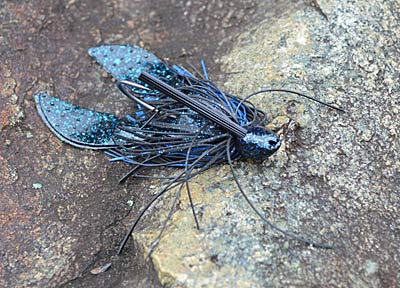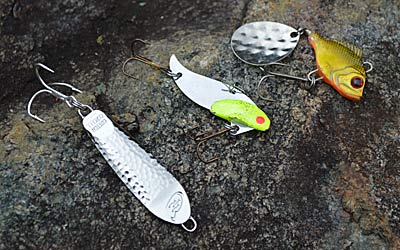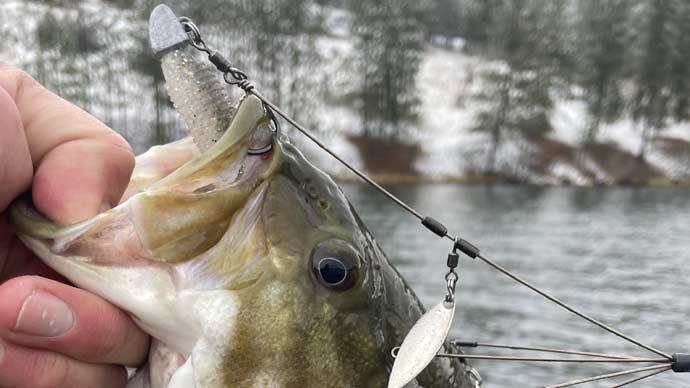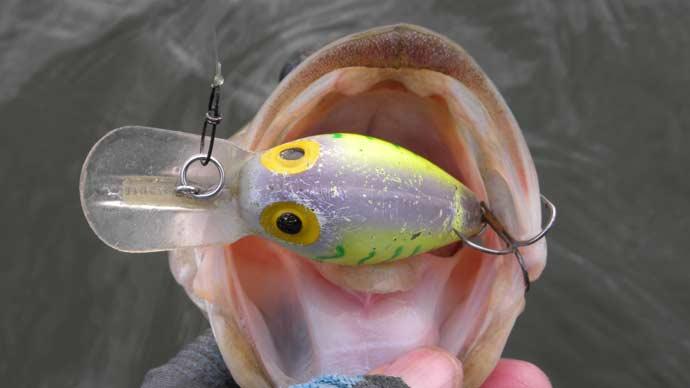
December can be numbing. The trees are bare; their leaves fell weeks ago. Everything is awash in shades of brown and gray. The water has a steely look. Then there are the frigid temperatures, which numb fingers and lock line guides in ice.
But the year’s end isn’t all frigid gloom. A warmth can be found at holiday celebrations with friends and family. And if you know what lures to fish and where to throw them, you can find plenty of bass willing to bite. And they’ll warm you better than any roaring fire.
December bass fishing requires you to focus on winter patterns. Those are built on understanding how bass react to cold water, which is relative to where you are fishing. In Northern fisheries, for example, the water temperature may be in the low 40s or high 30s. It might only dip into the 50s in Florida. But the effect on cold-blooded bass is the same regardless of where they swim. Their metabolism slows, and they seek out spots and food supplies that require minimal energy use. One or more of these approaches will work for you, regardless of where you fish.
Deep With Jigs
Jigs are the most versatile bass lure. They work in any water temperature, at any depth, and in and around any type of cover or structure. But they shine when the water turns cold and bass hunker down for winter.
Cold-water bass gravitate toward deep water. Like water temperature, depth is location-dependent. Deep water in a highland reservoir differs from that in a coastal tidal river. It could be a prominent lake bluff or creek channel swings along a bank. It might be a slight depression in a river backwater. The best deep-water spots have vertical structure, where bass can change depths quickly to meet changing conditions. Add some cover, such as the last green patches of aquatic vegetation or brush, and these spots become even better.
Fish your jig methodically. For example, if you're hunting largemouth with a traditional bass jig and trailer, you'll want to slide it along the bottom and through the cover. Aggressive hops or a swimming action are far less productive. It’s best to give it a crawfish-like appearance.
Largemouth aren’t the only bass you can catch with jigs in December. Smallmouth readily eat them, too, especially when they’re stacked in wintering holes on rivers. But trade the crawfish imitation for a baitfish one. That’s easy to do with one of these three jigs:
- Tubes: These soft-plastic baits are a perfect baitfish imitator with their undulating tentacles and darting movements. Generate more bites by experimenting with different jig-head weights and changing your tube's fall rate.
- Grubs: Fish these compact curl-tail soft-plastic lures two ways: slowly swimming with a steady retrieve or hopping along the bottom. If you choose the latter, don't be afraid to exaggerate your hops by raising your rod above your head. Most bass eat grubs as they sink, creating a longer drop.
- Underspin: While these can be retrieved at a constant speed to hold a consistent depth, they also produce a pull-and-drop cadence. Watch your electronics for schools of baitfish. When you find one, present your underspin just above it.
Mid-Depth With Crankbaits
Most crankbaits, such as a square bill bouncing through shallow-water cover or a long-lipped diver probing sunken brush in deep water, are associated with warm water temperatures. But crankbaits produce in cold water, too, provided you pick the best ones.
Diving depth is a limiting factor for a crankbait. But lucky for you, there’s always some bass within a crankbait’s range in December. Southern bass will hold along creek channels and rip-rap banks, perfect places to cast a crankbait. Northern bass will hold along the deep edges of what's left of aquatic vegetation and in slower and deeper sections of rivers. Most of these bass are in 15 feet or less.
All three of the most popular bass species — largemouth, smallmouth, and spotted bass — will eat a crankbait in December. You'll get more to bite if you slow your retrieve and include long pauses. Using fluorocarbon line, swapping stock hooks for slightly larger ones, and adding strips of lead tape to your bait’s belly will cause floating models to suspend or slightly sink, which will help rein in your retrieve speed to entice bites.
While the make or color of your crankbait isn't essential, you should pay attention to its shape and style. There are only two types of crankbaits that you need:
- Flat-sided diving: These create a tight wiggle, which is more appealing to cold-water bass than the wider wobble of rounded crankbaits. They’re often made from featherweight balsa wood, so plan on fishing them on 8-pound test line and a light-power casting or spinning rod.
- Lipless: Mostly associated with speed and noise, switch gears and fish them with a pull-and-fall retrieve. Use no-stretch braided line if you're fishing around submerged aquatic vegetation. A quick pop of the rod tip will clean any clinging to your crankbait's treble hooks.
Shallow With Topwaters
Image
Don’t stow your topwaters when the water temperature falls into the 50s or colder. They’ll catch bass that spend December chasing baitfish around the back of creeks or pockets in reservoirs. Photo by Pete M. Anderson It’s always topwater season when you fish the sprawling reservoirs that fill river valleys across the South. That’s because a healthy population of bass follow baitfish — typically small threadfin shad — into dead-end pockets and up creek arms in December.
Baitfish make this movement to find better water quality. While their reason is simple, finding them can be more complex. Wind, water levels, and sky conditions push them in haphazard directions. And while many bass blindly follow along, others tend to camp out next to available cover — a log, single rock or stump, dock corner, and boat ramps are some of the best — where they attack every school that swims by. So, you’ll catch more by aiming your casts at targets rather than attempting to keep pace with roamers.
Baitfish-focused bass will bite various lures, including jerkbaits, crankbaits, swimbaits, and spinnerbaits. Whichever one you choose, it needs to sport a baitfish pattern and be small in stature. That's the size baitfish bass key on in December.
One more lure option is a topwater, which fills both previously mentioned requirements. Here are three to choose from:
- Buzzbait: A steady retrieve and constant churning means you can cover a lot of water while attracting plenty of bass. Skip the soft-plastic trailer to keep it compact, but add a free-swinging trailer hook to catch those short strikers.
- Popper: This classic creates the sound and sight of a baitfish skittering across the surface. While you can vary its speed, don’t dawdle too long on the pauses. Shallow schooling bass want a moving target.
- Walking bait: Its steady side-to-side movement attracts huge bass numbers. Stick to translucent colors to provide all the action and none of the silhouette. That forces the bass to bite to find out what it is.
Deep Water With Umbrella Rigs
Umbrella rigs are made for fishing in December when you can find bass chasing baitfish at any depth. But these monstrosities are made for something other than searching for bass down a bank. They take a lot of work to cast, so focus on places that congregate bass. That could be a bend in a creek channel, a windblown point, or a neckdown such as a bridge across a creek arm.
Assembling an umbrella rig takes work. Get the most out of one using jig heads that sport large gap hooks. Swimbaits in baitfish patterns should be between 3- and 4 inches long. And it doesn't hurt to swap one for a slightly larger or brighter-colored swimbait. That gives bass a target within your imitation of a small school of baitfish. But be sure to check location regulations before you make that first class. The number of lures or hook points is limited in some states and on some waters.
Along with planning your casts, you can make fishing an umbrella rig easier by gearing up. Together, these will make casting one out and reeling it back easier:
- Rod: Choose one that measures 7 ½- to 8 feet long and has a heavy power and fast action. You want some give in the tip that allows the rod to load, making casting easier. Light-duty musky rods, for example, make excellent umbrella rig rods.
- Reel: Umbrella rigs work best on a moderate retrieve, so find a reel with a gear ratio of no more than 7:1. That’ll provide the power to winch them in, too. Wide spool reels pack enough line for bombing casts.
- Line: It's a simple choice: the braided line between 50- and 65-pound test. Go heavier as you add arms or bigger swimbaits. The line’s strength will handle the rig’s weight, and its lack of stretch will help you set the hook, regardless of which bait a bass bites.
Wintering Holes With Heavy Metal
Image
A jigging spoon, blade bait, or tail spinner is tough to beat when the water temperature is at its coldest and bass are at their deepest in December. They stay in the strike zone and imitate a favorite cold-water food — baitfish. Photo by Pete M. Anderson Some bass seek refuge on the bottom in deep water during December. The water temperature may be so cold that they don't want to be anywhere else. Others may be hiding from the current or setting up where they have the best shot at a meal of baitfish.
Reaching these bass requires a lot of weight in a little package. Enter jigging baits. Made from lead, steel, or tungsten, they quickly cut through the water and stay deep. They are tricky to use as search baits, so spend time reviewing maps and idling with your electronics before you pick up a rod. That'll help you identify possible spots, such as where a deep point falls into a main river channel, and locate the schools of baitfish that put bags there.
Three types of lures fall into this category:
- Spoons: These flashy baits have been catching bass for decades. They weigh more than their compact size reveals, making them perfect for deep water. Work them with a sharp upward snap, giving them enough slack line to flutter back down.
- Tail spinners: These rounded or fish-shaped chunks of metal sport a Colorado blade on the back. They sink nose down, making the most action as they fall. So, lift it as high as possible to create the longest drop.
- Blade baits: A thin piece of metal with a gob of lead and two treble hooks, these baits vibrate wildly with even the slightest pull. But they don’t have to be fished aggressively. Pull it just enough to feel its action in your rod, then stop and let it sink to the bottom.
BassResource may receive a portion of revenues if you make a purchase using a link above.




